
Neuroscience: A Journey Through the Brain
 |
Neuroscience: A Journey Through the Brain |
| Main Page Organization Development Neuron Systems About the site (Glossary) References |
Differentiation and Diversification
|
Development Home Neural Induction Diversification Migration Synapse Formation |
The nervous system develops from primitive precursor cells, and thus a mechanism to differentiate neuronal cells is necessary. There are 4 controlling mechanisms for determining cell identity:
|
Cell Lineage (back to top) Some cells have intrinsic, hard-wired phenotypes. For example, in C elegans, transplanting a precursor cell (shown in yellow) to another location will not change it's phenotype.
|
|
|
Neighboring Cell (back to top) For some cells, their differentiation is controlled by the cells that surround them. For example, the development of the ommatidia (light sensitive part of the insect eye) is governed by neighboring cells. Cell 8 induces the differentiation of cells 2 and 5, which induce cells 3 and 4, then 1 and 6. Cell 7 is induced by UV light.
|
|
|
Local Environment (back to top) Some neurons change their phenotype as they migrate towards their target site. Different chemical gradients present along the migratory path can change the neural phenotype. For example, neural crest cells can develop into either Adrenal chromaffin cells (when glucocorticoids are present) or sympathetic neurons (when FGF and NGF are present).
|
|
|
Target (back to top) Diffusable signals from the target organ can keep the growing neuron alive, guide it to its target, and change its phenotype. In this example, the sweat gland receives innervation from Ach fibers, while the parotid gland receives NE innervation. Transplanting these two target organs results in a different migration path followed by the axon terminal, and thus a different neural phenotype.
|
Created and Maintained by: Melissa
Davies
Last Updated: April 10, 2002 09:05 AM